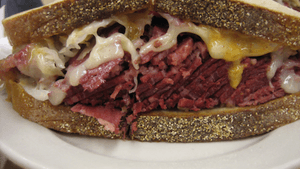Stay in the Loop
BSR publishes on a weekly schedule, with an email newsletter every Wednesday and Thursday morning. There’s no paywall, and subscribing is always free.
Authors Roger Horowitz and Ted Merwin kibitz about noshing
The Gershman Y presents 'The Evolution of Jewish Food'

Whether out for a deli meal, celebrating a wedding or Bar Mitzvah, or any holiday with my own family or my wife’s, I’ve noticed one thing: when it comes to Jews, it’s all about the food. Roger Horowitz and Ted Merwin disscussed their books Kosher USA: How Coke Became Kosher and Other Tales of Modern Food and Pastrami on Rye: An Overstuffed History of the Jewish Deli at the Gershman Y Monday night. The talk, titled "The Evolution of Jewish Food," offered a look at the unique history of Jewish food and how it ties into very American notions of culture, community, and assimilation. Let's just say it was not a good event to attend on an empty stomach.
From shtetl to deli
“I guess I always had a sense that food mattered a lot to Jews,” said Merwin, in one of the greatest understatements imaginable. Indeed, the two men’s books intersected in a fascinating way, as pointed out by both authors: over the years, many Jews raised in secular backgrounds have embraced their Jewish heritage and ancestors’s traditions by enjoying deli food, using delis as gathering spaces, and even, some cases, opening new ones. At the same time, many Jews who keep kosher have gone to creative lengths to come up with kosher versions of popular American foods. In other words, we're all assimilating, in one direction or another.
Horowitz shared the example of the time Coca-Cola was made kosher with a subtle formula change suggested by a rabbi in the 1930s; now, you can easily buy a kosher hot dog at Yankee Stadium.
Then there’s Mexikosher, New York City’s first-ever kosher Mexican restaurant (there’s also a Mexikosher branch in Los Angeles). A friend of mine recently kvelled on Facebook about a visit to the Manhattan Mexikosher, and the joy of watching kosher-keeping friends ordering Mexican food for the first time in their lives.
Merwin’s book traces the history of the deli, from the early 20th century when Sunday night at the deli seemingly replaced Friday night at the synagogue, to the rise of delis through such popular culture as When Harry Met Sally…, Annie Hall, and Seinfeld. “We’re nostalgic for the food,” Merwin said, “but less so for the public gathering spaces,” he said, referencing the tendency that delis today are often filled with as many non-Jews as Jews.
There’s also a look at the economics of delis today. “They couldn’t sell enough sandwiches to make the rent,” Merwin said of several old-style delis that have closed in recent years; the ones in New York that have survived, like Katz's, had the good sense to buy their building years ago.
What is Jewish food?
The geographical element of this shouldn't be overlooked. I’m originally from Minneapolis, where there haven’t been any great delis for many years (RIP, the Lincoln Del), and this is true for much of the country. When in town for my wedding nine years ago much of my family made pilgrimages to Famous 4th Street Deli; I even remember my grandfather trying to talk the manager into opening a Midwestern outpost. Ever since, whenever I’ve had Jewish visitors in town, that’s always their first lunch choice.
Not the panelists, though; they dined at Schlesinger’s at 15th and Locust prior to the talk. It was more geographically convenient, plus, it has a pickle bar.
More recently, young Jewish entrepreneurs have opened new delis in several cities, like Harry & Ida’s Meat and Supply Co. in New York and Wise Sons Jewish Delicatessen in San Francisco, which have embraced the food traditions of the past, if not the kosher dietary laws. And there’s one other place where deli food is thriving: Las Vegas, where several major casinos have replicas of popular New York delis, such as the Carnegie Deli in the Mirage and Stage Deli at the MGM Grand.
The talk was also a look at the odd ways American cultures bleed into one another. Did you know that Manischewitz was exceedingly popular among African-Americans in the 1950s and '60s, to the point that Sammy Davis, Jr. was once its spokesman? Did you know, as covered in Horowitz's book, that the famed animal behavior scientist Temple Grandin once pushed for more ethical kosher slaughter practices, in the process going toe to toe with rabbinical authorities? And did you know that American-style Jewish delis are all but unheard of in Israel?
That’s because, as Merwin said, there’s not really any hard definition of what “Jewish food” is. Throughout history, Jewish food traditions have come from wherever in the world Jews were at the time. Whether inspired by the culture of Eastern Europe, Tel Aviv, or the Upper West Side, it’s all delicious, and there’s always a lot of it.
What, When, Where
How Coke Became Kosher and Other Tales of Modern Food. By Roger Horowitz. Columbia University Press, 2016. 327 pages, hardcover; $26.22, available at amazon.com.
Pastrami on Rye: An Overstuffed History of the Jewish Deli. By Ted Merwin. NYU Press, 2015. 256 pages, hardcover; $26.95, available at amazon.com.
Sign up for our newsletter
All of the week's new articles, all in one place. Sign up for the free weekly BSR newsletters, and don't miss a conversation.

 Stephen Silver
Stephen Silver